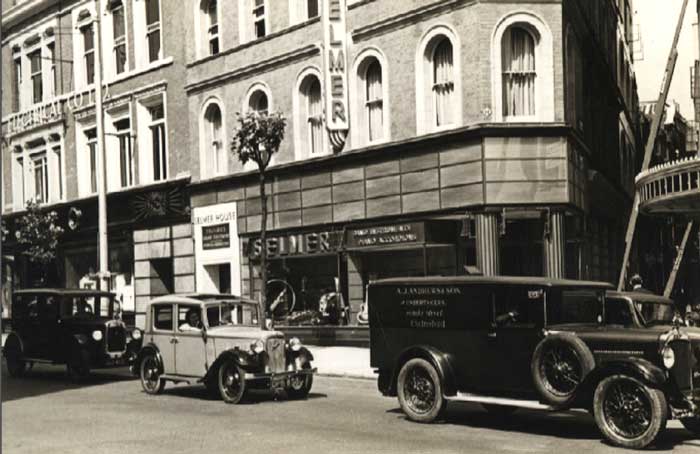

114-116 Charing Cross Road, London - The Home of the Selmer London Company in the 1940's.
By coincidence, the first shoots of the Selmer Company
appeared at round about the same time as those of the Karl Hӧfner Company in the
mid 1880’s. The paths of the two were destined to come together briefly in the
period between the First and Second World Wars, but most significantly again in
the early 1950’s when a mutually beneficial association began which was to
influence Hӧfner for many years.
Henri Selmer was born in France in 1858. He grew up to
become a musician, playing clarinet in the French Republican Guard and later
with the Opera Comique and Lamoureux Orchestras. He set up in business in 1885
initially producing reeds and mouthpieces for clarinets, just two years before
Karl Hӧfner had begun manufacturing violin bodies under his own name in Bohemia.
As had happened with Karl, Henri Selmer’s company quickly expanded with the
introduction of his instruments into the Unites States, so by the end of the
First World War, it had become a major musical instrument manufacturing company
based in Paris.
A third member of the cast now enters the scene – a
saxophone player by the name of Ben Davis. After playing Jazz and Dixieland
music in the UK following his leaving the British Army after the First World
War, Ben, being
the very shrewd person that he was, could see that there would be more of future
selling musical instruments than playing them for a living. In 1928 therefore,
following a meeting with Henri Selmer, Ben set up the Selmer Company in London
at 114-116, Charing Cross Road. The exact terms of the agreement between Ben and
Henri are not known, but it would appear that Selmer London had a great deal of
independence from Selmer Paris. In the period up to the re-commencement of war
in 1939, Selmer London became one of Karl Hӧfner’s many customers.
After peace had returned to Europe, Ben joined at this
stage by his brother Lew Davis, put all their efforts into developing the
business and in fact they moved away from the French company by integrating
Selmer London into a public company called Musical and Plastic Industries in
1953. The other half of this company rather bizarrely manufactured plastic toys
and garden furniture!
Ben and Lew needed products to sell both wholesale and retail in their palatial showroom in Charing Cross Road. The obvious place to buy guitars from was the USA whose manufacturing industry had not been greatly affected by World War Two. Just one problem though…the UK government had put import restrictions on US manufactured goods. Britain was bankrupt after funding the war for six years, and the US now wanted re-payment for the loans made to Britain during and after the war. Becoming even more in debt to the Americans due to British consumerism did not seem to make sense to the UK Treasury, so US-made guitars were definitely not an option until 1960 when the restrictions were finally lifted. Guitar making in the UK was very much a cottage industry at that time, so it was natural that Ben Davies would have remembered that company from Schönbach who had supplied Selmer with a few violins and guitars before the war.
It was not guitars however that Selmer London first obtained from Hӧfner after World War 2, but double basses from March 1948 onwards. This was of course the Big Band and Jazz Band period, and the enormous demand for guitars was still a few years away.
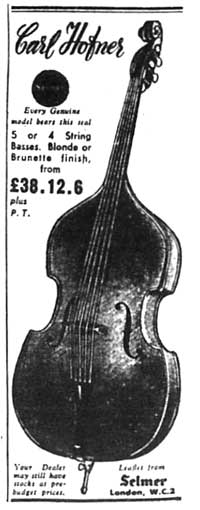 |
Selmer Advert in Melody Maker April 1948. (Note the incorrect spelling of Karl.) |
Somehow or another, probably in 1952 but it could have been even earlier, Ben Davis and Josef Hӧfner must have met and agreed a deal. From then on, Selmer London was to become Hӧfner’s distributor for their guitars, not just in the UK but also throughout the British Commonwealth. That in turn opened up a very large world market for the sale of Hӧfner guitars.
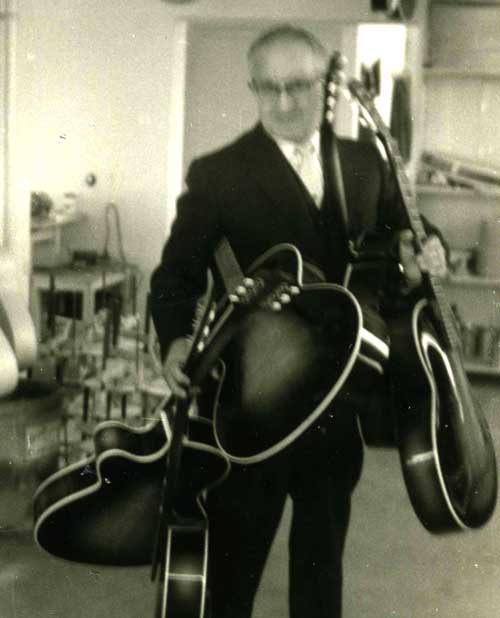
In 1952, Selmer set about
publishing a new eight-page
brochure to feature the guitars available from the company.

Although the new brochure also includes other instruments
such as three Selmer-branded lap-steel guitars and a Truvoice 15 watt amplifier
together with four Hӧfner–made guitars, the emphasis is definitely on Hӧfner,
with the brochure being given the title “Hӧfner 1752-1952.”
It would appear that Ben Davies’ enthusiasm was perhaps a little too
supercharged here, as in his determination to provide Hӧfner with the reputation
of being a long-standing company with 200 years of experience, he had overlooked
the fact that the founder of the company, Karl Hӧfner, had not been born until
1864! Nevertheless, the President, Senator, Square Dance, and Concert looked
magnificent in the illustrations. The descriptions against each model were a
little over the top, but hey, we do have a message to get across here!
For instance, the President model description:
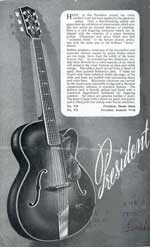 |
“Here, in this
President model, the violin makers’ craft has been applied to the plectrum
guitar. Only a discriminating soloist can appreciate the subtleties of
construction which give the new guitar an unusual delicacy of response. Here is
a rich lingering sostenuto which can be clipped with the crispness of a piano
damping action. Glissandos and slurs, which give that “orchestral finish” to the
feature chorus, articulate with the same ease as the brilliant “brass”
chords……..” |
In the Concert model description, the following is advised:
 |
“As each instrument
receives the personal attention of Karl Hӧfner, only a limited number can be
built and orders will be dealt with in strict rotation.” The “Concert” model was actually a re-named Hӧfner 497
Classical model, which although being a good quality instrument (what Hӧfner
described as a “Master Guitar”) may not have been given too much
attention from the company’s founder, who much preferred violins to guitars. |
The first three Hӧfner cello guitars supplied to Selmer provided a model for most pockets and abilities, the "President", the "Senator", and the "Square Dance". Ben Davies wanted something a little special for the UK so instead of simply taking existing models, he had insisted that up-grades be made to the usual Hӧfner specifications in order to obtain a more luxurious product for his customers.
1952/53 Hӧfner President (Note: the pickup and volume control were added later by a previous owner.)
So, although the President model was based on Hӧfner’s existing 457
model, Ben required the following changes to be made:
The President was therefore the first Hӧfner model to be
offered with an option of either “blonde” or “brunette” finishes. This was
almost certainly at Ben Davies’ insistence, and it marks the first of many times
when Ben’s ideas for his own range of guitars would be subsequently adopted by
Hӧfner for their standard range. Blonde finishes on guitars such as the 455,
456, and 457 began to appear in the general Hӧfner price list from 1954 onwards.
The Senator model was in fact an up-rated Hӧfner 455
archtop. The differences being:
The Square Dance model is a difficult one to fit into
the
story of how Hӧfner adapted their standard models to meet with Ben Davies’
expectations. There doesn’t seem to have been an equivalent model in the
standard Hӧfner range at the time! It seems that an earlier and what appears to be
an identical Hӧfner model had been supplied to Selmer prior to 1952 which is
probably the year in which the first brochure described above was published.
This was called the Hӧfner “Four Square”. It is probable that this model was
supplied to Selmer (and maybe other UK wholesalers) prior to them becoming Hӧfner’s
sole distributor for the UK as a very cheap guitar made with the sole purpose of
providing the impoverished Brits with a means of making music.
The main features of the “Square Dance” (earlier known as
the “Four Square”) were:
This guitar would soon metamorphose into the much loved
and more capable Congress model two or so years later.
Less than a year later following the launch of the above
three models, it would seem that the admirable President model,
although being a thoroughly good workhorse of an archtop guitar like its cousin
the 457, did not totally match Ben Davies’ aspirations to supply the leading
British musicians with an equivalent (in looks, if nothing else) to
the Gibson L5. He was obviously hoping that a big, flash, 17¼” wide large bodied
Hӧfner guitar would look well on stage in the hands of the time-served
guitarists with the popular bands of the day such as the Billy Cotton, Ted
Heath, and Joe Loss dance bands. Things actually worked out a little differently
though!
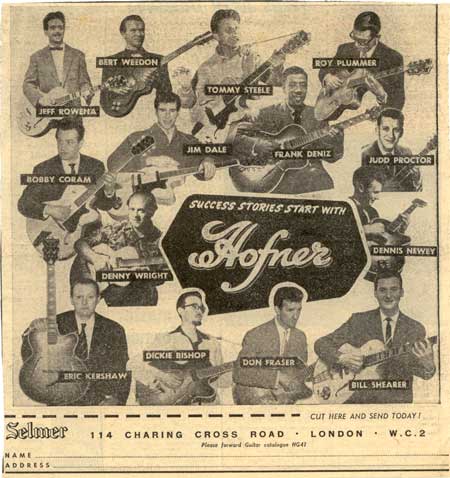
The Selmer advertising stated that “Frank Deniz, Ike
Isaacs, Jack Lewellyn, Freddie Phillips, Roy Plummer, and Bert Weedon worked
together in producing the design of this super guitar.” Here were the names of
most of Britain’s top session and band guitarists during the 1950’s. When they
weren’t playing in specific dance orchestras, bands, or jazz ensembles, they
were dashing around London going from recording session to recording session in
order to back the latest “crooner” to hit the steadily expanding popular music
culture in 1950s Britain. Would it have been possible to pull these guys all
together around a table at the same time in order to discuss their preferences for
the new Hӧfner guitar?
Matters surrounding this supposed “committee” of guitarist
get even more cloudy when one considers that Ivor Mairants, probably the most
well-known guitar exponent in the UK back then, has stated that he was
actually approached, presumably by Ben Davis, to allow the new Hӧfner to be
named after him, but he refused on the basis that he much preferred the sound of
the Epiphone Emperor that he was playing at the time.
Perhaps a clue to the level of involvement of the six
“committee” members can be gained from a photograph which appeared in Melody
Maker that was taken in the late 1940’s, a few years prior to the Hӧfner
Committee making its appearance. This shows what is obviously a Selmer-arranged
launch of the new Straten Symphony archtop guitar, with a collection of
guitarists including Jack Llewellyn and Jack Deniz in attendance. Perhaps the
“committee” input for the new Hӧfner was on a similar very informal basis?
Whatever, it seems to be an unfortunate fact that the committee members all had
their own preferences for their personal guitars which doesn’t seem to have
changed too much after the launch of the Hӧfner Committee; the hard to
obtain Epiphone brand being especially popular. Bert Weedon was the only one to
use Höfners almost exclusively through into the mid-1960’s, after which he
changed his allegiance to Guild, reputedly following total exasperation with the
reliability of the electrics fitted to Hӧfner guitars at the time.
Whatever the design heritage of the Hӧfner Committee, it certainly was a very impressive instrument when first introduced in late 1953 as a full acoustic archtop. The large 17¼” body gave an impression of importance, but this was totally eclipsed by the headstock. Officially described as a “frondose” shape, this resulted in a headstock bigger than seen probably on any other guitar before or since. It would not have looked out of place on the front of a carved Bavarian cuckoo clock, also fashionable in the UK at the time. No committee of British working guitarists ever came up with that design! Special tuners with long peg-shafts had to be made in order for the ornate (and very fragile) plastic buttons to clear the erratically-shaped sides of the headstock. And then there was the mother of pearl inlay work on the headstock fascia and fingerboard…
1953 Hӧfner Committee Acoustic - Serial No. 2000 - the very first production one.
The main features of the Hӧfner Committee as originally
introduced were:
1955 Hӧfner Committee Electric
1958 Hӧfner Committee Electric
A major change occurred to the Committee models however in
1962. At that time, the 18” bodied Golden Höfner was discontinued, and Höfner
(or maybe more likely Selmer) presumably felt that this would leave a gap in their archtop range. The new Committee was therefore provided with a Golden Hofner 18”
body profile. At the same time, the Frondose headstock was ditched and replaced
with one of a conventional shape. The specification of the Committee from 1962
onwards was therefore:
Selmer now had a full-range of archtops, from the flamboyant
through to the workman-like, and down to the budget level.
Sometime around 1955, Hӧfner’s budget guitar was up-rated,
being given a domed body top (table) and back. Perhaps Hӧfner had finally got
around to making up the necessary moulds for pressing a domed laminated top for
a 14 ½” bodied guitar, or perhaps it was once again Ben Davies pushing for that
little bit extra for his Selmer-distributed range of instruments all the time.
Certainly, a few other improvements also appeared, such as simple
mother-of-pearl inlays to the headstock fascia, double dot fret-markers, and a
pickguard that was now suspended over the body top and not simply screwed down
onto it as with the previous model. Even the name, Congress sounded much less
frivolous than “Square Dance”, and it now fitted in well with the US theme set
already by the “Senator” and “President”. There was no doubt in Ben’s mind as to
which country led the rest of the world with regard to popular music.
At its introduction in 1955, the main features
of the Congress were:
Laminated maple body, with some flaming on body
back
S
The Congress was to become Hӧfner’s best-selling
Selmer-distributed archtop model, with sales of well over 13,000 before being
discontinued in the early 1970’s.
Selmer commenced importing the Hӧfner Club 40
and 50 in September 1955 with the Club 60, appearing in 1958, almost certainly after
Ben had asked Hӧfner to produce a deluxe version.
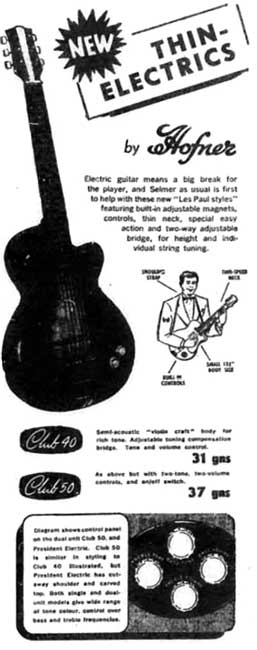 |
Advertisement
from September 1955 in which Selmer introduce the Club 40 and Club 50 guitars to the UK. Note the reference to these guitars being "Les Paul style". |
An account of how Selmer’s “Clubs” fitted into the story of Walter Hӧfner’s 125, 126, and 128 models is given in the previous chapter. However, it may be worth reflecting at this stage as to why Ben Davies gave these little guitars the name “Club”. Selmer had actually used the name “Club 40” for a particular model of Straten guitar back in the late 1940’s/early 1950’s when Dick Knight, who was Straten’s luthier, worked direct for Selmer London making his fine archtops. There was therefore some history behind the use of that name for the new little Hӧfner, and also the "Compensator" tailpiece fitted to many of the Hofner guitars supplied to Selmer and which had been originally designed by Lew Davies in the late 1940's for use on such guitars as the Stratten Club 40.
As we have implied above, Ben Davies didn’t get many things
wrong. However, in 1957 he commissioned Hӧfner to make a rather bizarre version
of the Senator. This guitar was presumably intended to satisfy the demands of
the “show business” and “cabaret” artists back in those days for glamour and
glitz……….but not in the same way as the Golden Hӧfner! The Colourama model (not
to be confused with the Hӧfner Colorama solid models) was finished in what the
catalogue described as “glitter nacrolaque” in either red, gold, or silver
finishes. Two colour "nacrolaque" was also used for the headstock fascia and fret
marker inlays.
This model did not sell well, and only two or three
examples are known to currently exist, which therefore gives the Colourama the
distinction of being one of Hӧfner’s rarest guitars.
The Hӧfner Committee was by 1957 demonstrating good sales
in the UK. This happy trend was being helped along by the use of that model by
some of the new British “rock n’ roll” artists, in particular Tommy Steele.
Tommy was really the UK’s first “superstar” of Rock n’ Roll. ”Discovered” in
1956, he seems to have always appeared on stage playing (some would say “posing
with”) a blonde Hӧfner Committee. This must have been exactly the exposure of
the Committee that Ben Davis had been hoping for. Tommy Steele sold records in
hundreds of thousands….and Hӧfner Committees in hundreds! Bert Weedon was also
gaining further public recognition at this time, and of course it was a blonde
Committee that he was soon mostly likely to be seen playing.
Perhaps it was this type of exposure that
prompted Ben Davis to believe that the envelope could be pushed further. Why not
an even better appointed version of the Committee for such big-name celebrities?
So, “OK, Höfner. What can you give me?”
At this time, around late 1957, Hӧfner had produced nothing
more luxurious than the Hӧfner Committee and its European market cousin, the 468
model. However, if Ben wanted even more then, being Hӧfner’s best customer, they
were not going to disappoint him. The new guitar was given the name “Committee Deluxe” in the
Selmer catalogues, although Hӧfner simply typed “Deluxe” on the body labels.
The Hӧfner Committee Deluxe, as advertised in the Selmer London catalogue of 1958.
The basic Committee design was used, including
the 17¼” body width and frondose headstock, but with the following additions:
| The fact that the guitar was available only in natural
blonde finish was indicative of the pride that Hӧfner took in the superb flame
maple laminates used on this lovely guitar. Ben Davies’ angle on it was probably
that the guitar could be more clearly seen and recognised on a television
screen! Supplying the guitar only as an acoustic is a little more difficult to
understand. Perhaps it was felt that screwing pickups and controls onto such a
magnificent-looking instrument would detract from the craftsmanship that had
gone into it. Maybe it was simply believed that making the guitar any more
expensive would not be sustainable. After all, with a price tag of 80 gns, the
acoustic Deluxe already cost 15 gns more than a standard electric Committee. The Committee Deluxe appeared in just one Selmer catalogue edition printed in 1958. Because of this, the vast majority of avid Hӧfner enthusiasts, including myself, were totally unaware of the existence of the model until only about 15 years ago. Things only changed when the internet allowed more photographs of such people as Bert Weedon and Tommy Steele to become available for general viewing. It was only then when it became apparent that there had actually been a predecessor to the much better-known Golden Hӧfner. Since then, a handful of Deluxes have appeared and by studying their serial numbers and using a little guesswork, it would appear that probably only around thirty were ever made, during 1958 and the first half of 1959. It may also be that a small proportion of electric versions were produced, despite not being offered in the catalogue. Bert Weedon had what appears in photographs to be a Deluxe fitted with twin Hofner “ Bar” pickups, and what could well be a prototype fitted with just a single bar pickup in the bridge position can be seen in many of the (unfortunately indistinct) photos of Tommy Steele. |
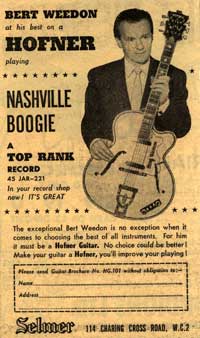 Selmer London Advert in Melody Maker c1959 |
What is very clear however is that Selmer wanted an
ultimate version by mid-1959. Something as grand as the Committee Deluxe, but
with an 18” wide body in order to rival the Gibson Super 400. Enter the Golden
Hӧfner!
Production of Golden Hofners commenced in the last half of
1959, and they were introduced into the Selmer catalogue at about that time.
Contrary to the policy that had been adopted for the Deluxe, the Golden was
offered from the start with options for twin-pickup electrics and also an
electric thin-line model. Perhaps it had been realised after experience in
marketing the Deluxe that in-built means of amplification were now essential for
professional-level instruments. It had been planned to introduce adjustable neck
truss rods into the whole Hӧfner range at the beginning of 1960, but the very
first Goldens made in late 1959 were given the privilege of having truss-rods
fitted a few months earlier. Another innovation planned for the beginning of
1960 by Hӧfner was the introduction of their new “Toaster” single coil pickup,
made by Franz Pix. However, the very first few Golden electric versions were
fitted with the old “Bar” units.
The differences between the Committee Deluxe and the Golden Hӧfner can be summarised thus:
The price of the acoustic Golden Hӧfner in 1960 remained
the same as that of the previous Committee Deluxe at 80 gns. The Electric and Thinline versions of the Golden both retailed at 95 gns.
The acoustic version of the Golden was advertised as having a body top of
“…well-seasoned pine, selected by craftsmen... hand carved and specially bowed.” That probably was the general
case with the acoustics, but close inspection of most electric and thinline
electric Goldens reveals that their bodies were made of laminated spruce, which
is perhaps disappointing.
As was now becoming the norm, Hӧfner took notice of Selmer’s decisions as to what they wanted producing. Walter and Josef Hӧfner obviously had a great respect for Ben Davies’ judgement and so whilst fixing the Committee Deluxe specification in 1958, they decided to produce a similar luxury 17 ¼ ” model for their other European and Worldwide markets. This resulted in the introduction of the Hӧfner 470 model into Hӧfner’s main catalogue in 1958. The 470 however differed from the Committee Deluxe in an important aspect; a normal sized (and shape) “Gibson-style” headstock was used instead of the flamboyant “frondose” head of the Deluxe. Less important differences were that the headstock inlays on the new 470 were of the “bell flower” design rather than the “rose flower” for the Deluxe, and double arrow-head inlays were used for the fretmarkers in place of the Deluxe’s more delicate rose-twirl pattern. Both acoustic and electric versions were offered, but strangely, Hӧfner delayed the introduction of the 4700 Thinline model for nine years until 1969.
1958 Hӧfner 470/S/E2 Electric Archtop Guitar.
The actual numbers of Goldens made over their production
period between mid-1959 and 1962 is not known for sure. However, from the serial
numbers that have surfaced over the years, it would seem to be slightly less
than seventy full-bodied acoustic and electric guitars and approximately fifteen
Thinlines. The surviving guitars rarely appear on the market, being cherished by
their owners who quite rightly consider that such examples of fine workmanship
and eye-stunning glitz are unlikely to ever be produced again.
Unfortunately for Hӧfner and Selmer, the Golden Hӧfner was
an anachronism before the very first one was shipped out of Bubenreuth. It was
quite simply five years too late. The popularity of archtops was waning, due to
both changes in the popularity of styles of music and also the introduction of
guitar types with greater playability, such as solid and semi-acoustic thinline
instruments. Even the “show” element of “show business” was being overtaken for
a more down-to-earth form of performance, which of course finally culminated in
the Beatles, long hair, and the 60’s pop revolution. Ben Davies had
missed the boat with this one; a very rare occurrence for that shrewd business
man.
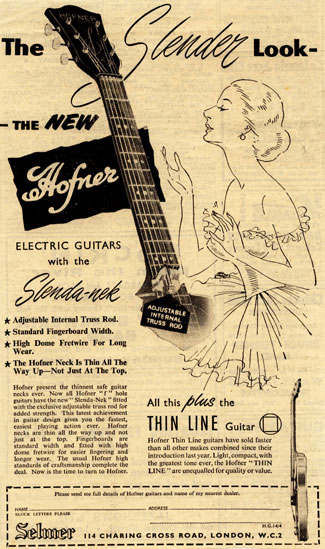 Selmer London Advert in Melody Maker 1960 |
An archtop guitar is perhaps not the most comfortable guitar to play. This is due to the body size and depth which as a standard is of a 16” and at least a 3” depth. Maybe not too bad when sitting down, but getting one’s arm over such a body when it is on a strap is not particularly comfortable. And then of course there are those body widths of 17” and 18” on the more expensive guitars... Gibson in the USA must have had this matter very much in
mind when in 1955 they introduced their ES-225T model, shortly followed by the
Byrdland and ES-350T. OK, there was of course a trade-off in acoustic tone
between the thinlines when compared to full depth bodies, but hey, everyone was
now starting to play amplified archtops with all sorts of things like pickups
and potentiometers screwed down onto the once important “table”, so perhaps the
acoustic
tone issue wasn’t that relevant any more. Thinline versions of the Hӧfner archtops first appeared in
the Selmer Catalogue in 1959. The electric versions of the Committee, President,
and Senator models were from then on all offered with the option of a Thinline
2” deep body instead of the standard 3”. It is again significant that it was
those models made especially for Selmer that received this option first out of
all the archtops that were then been shipped out of Bubenreuth, (although a
variation of the 457/S/T2 model had actually appeared in the 1958/59 Hӧfner
general market catalogue with a 6 cm. (2.4”) deep body.) So why were the Selmer-distributed instruments a year in
advance of Hӧfner’s standard range? It can only be that Selmer London, and Ben Davies
in particular, had sensed that Gibson were onto a winner with the new Thinline
idea and wished to take full advantage themselves. Selmer had the buying power
and therefore commercial clout to ensure that Hӧfner did as they were asked. It
took the more traditional-thinking Germans some time to realise that Selmer were
right and that perhaps they should adopt the idea for those standard range
archtops marketed directly by themselves. We will consider how Hӧfner developed
the concept in the next chapter.
|
In February 1958, the Gibson Company in the USA announced a
radical new type of guitar to the World. This they designated the Gibson ES-335
T. The new guitar had a 1 ¾” Thinline body with arched top. However, its most
revolutionary visual feature was the twin symmetrical cutaway shape of the body
which allowed almost full un-hindered access to the highest section of the neck.
There was more of a surprise hidden away though. The body was not entirely
hollow as a centre block of maple ran down the full length of the body which was
therefore effectively split into two acoustic cavities, each with its own
soundhole. The definitive semi-acoustic guitar had been born!
Hӧfner’s new thinline really was just that, but more so with a body width of 30mm (1.25”), half an inch shallower than the Gibsons. Perhaps Walter didn’t quite understand the idea behind the centre tone block, or maybe it was a case of him not being prepared to move that far away from the all-hollow principle of the archtop guitars that Hӧfner had produced up to that time. Whatever, the new “Verithin” was fully hollow, like the Gibson ES330.
In common with all their mid-range archtops, the Verithin was provided with plenty of ornamentation, including the mother of pearl inlayed “bell flower” design on the headstock, multiple strip fret-markers, binding to the neck and soundholes, and plenty of body edge purfling. This degree of bling was only to be found on the top-of-the-range Gibsons; labour costs were cheaper in Germany than in the US! The body top was also made of laminated spruce, as opposed to the laminated maple used on the ES-33X models.
The finish adopted by Walter for his new guitar was
initially “Russet Red”, which was soon changed to the brighter “Cherry Red” a
year or so later, and in fact almost exclusively red Verithins were shipped to
Selmer in the UK continuously from their introduction in 1960 through to around
1967 when Selmer stopped their orders for that model. It is interesting to note
that Gibson started offering cherry red ES33X guitars from sometime in 1960
after Hӧfner’s red Verithins had arrived on the market. Perhaps that great
company in the States had actually learnt something back from Hӧfner?
Selmer offered their own vibrato unit, which was licensed from the Bigsby Company in the US, as an option on all their Hofner electric archtop guitars. This proved to be a very popular option on the Verithin, and in fact it appears that more of that model were supplied fitted with a Bigsby than with the standard Lyre-type tailpiece. Initially, the electrics fitted to the Verithin were the Hӧfner rectangular console controlling twin “Toaster” pickups during 1960 and most of 1961. However, the controls and pickups changed over the years in line with all the other Hofner models. One unique difference between the Verithin and the other models however was the option of stereo wiring offered for a couple of years or so around 1963-65.
At more or less the same time as Hӧfner had begun supplying
the Verithin to Selmer, the same guitar was put on offer to all Hӧfner’s other
worldwide markets, designated as the 4574 model. As well as being offered in a
few more finishes in addition to Cherry Red, these European and World market
guitars were developed further into a myriad of different versions on the same
30mm body theme, one of which was the 4575 model. A small number of
Selmer-distributed Verithins were also supplied fitted with three pickups, these
being re-badged Hӧfner 4575 guitars.
In 1965, probably in an attempt to revive the flagging
sales of Hӧfner archtops in the UK, it would appear that Selmer asked Hofner to
consider updating body cutaways from the traditional “curved” Venetian style to
“pointed” Florentine. This request was taken up for both the existing Verithin
and the President models, together with a totally new model called the
Ambassador (see below). The Florentine-bodied Verithin “66” first appeared in
the September 1965 Selmer catalogue. The “66” was a marketing man’s ploy which
gave the impression of the guitar being a brand-new product based on the
anticipated date of sale of the new guitar, although around 200 units had
actually arrived in the UK by the end of 1965. Unfortunately, nobody bothered to let Hӧfner
know about the “66” designation, and presumably for the want of further
instructions the people at Bubenreuth decided to call the new guitar “Verithin
Deluxe” which they promptly began typing on all the body labels! After a couple
of hundred guitars with the wrong labels had been delivered to London, Selmer
realised the mistake and instructed Hӧfner to type “Verithin 66” on future
labels. Things became even more confusing later on from late 1966 when catalogue
numbers were also added to the body labels, i.e. “Verithin 5137 (66)”.
The President’s change from Venetian to Florentine also
took place in the latter half of 1965 for both the full-depth and thinline body
versions. It was not a great commercial success though, with only around 500
Florentine Presidents were made, compared to the 9,000 Venetian-bodied version.
The Florentine Verithin 66 didn’t do any better though with only about 400
produced, as against 4,000 of the Venetian cutaway version.
The old non-cutaway Senator model was also up rated by the
adoption of a body cutaway at this same time. This change however bucked the
trend as the Senator “66” model, as it was then called, was given a Venetian
(rounded) cutaway rather than the Florentine.
The last Hӧfner-branded
guitar model to be introduced by Selmer to the UK was the Ambassador which
appeared in the UK during 1965. At first glance at the twin Florentine cutaways,
one could be excused for saying that the design of this guitar had been more
than heavily influenced by the Gibson Barney Kessel, but maybe that isn’t quite
fair. For one thing, the Ambassador’s body dimensions are totally different to
those of the Gibson. The lower bout measurement of the Hofner is an average
15.25”, which doesn’t line up with the above-average 17” of the B-K. Also, the
depth of the Ambassador’s body is that of a thinline archtop, 2”, rather than
the B-K’s Jazz guitar size of 3”. Although both guitars had fully hollow bodies,
it would appear that the B-K was intended for jazz whereas the Ambassador was
more of a general purpose guitar, and perhaps more useable with that smaller
body. In effect, it was similar to the President Thinline with double Florentine
cutaways and a different neck/body joint.
Strangely though, the Ambassador felt more like a Gibson
than a Hӧfner. Rather than the lightweight delicate feel of most Hӧfner archtops
including the President, the Ambassador felt more rugged and workman-like.
Perhaps that was something to do with it having a long body/neck joint rather
than the usual Hӧfner short joint with its cantilevered fingerboard extension.
Yes, this type of joint had been introduced with the Verithin, but another ¾” of
body and hence joint depth certainly made a difference. Other than that, all the
usual mid-range Hӧfner appointments were there, including the mother of pearl
inlaid headstock and binding to the neck and soundholes.
When first introduced, the Ambassador was fitted with two
twin-coil Type 511 “Staple” pickups. However, within a year or so, an Ambassador
Deluxe version was made available fitted with American DeArmond pickups as an
option, and all for the small additional surcharge of six guineas! In 1967, the
last few “standard” Ambassadors made were given the new Hӧfner Type 513 “Blade”
pickups. It would seem that some at least of these last Ambassadors were also
provided with a centre sustain block, a development that was to continue on
general-market Hofner twin cutaway thinlines.
By 1968, the Ambassador had disappeared with only around
500 being produced over four years. It now seems rather a shame that one of the
nicest thinline archtops made by Hӧfner should have suffered such a fate in the
UK. The good news is however that Hӧfner had starting selling their 4578 model,
which was basically the same guitar, to their other markets in Europe and around
the World from 1967. The 4578 was successful outside Britain and in fact
continued in production until 1981.
Did we say that the Ambassador was the last Hӧfner model to
be introduced into the UK by Selmer? Well, that is indeed strictly the case.
However……..in 1967, Selmer London instructed Hӧfner to produce a range of
guitars; acoustic archtops, electric thinline archtops, and even a Jumbo
flattop, all of which were branded “Selmer” with no reference to their Hӧfner
origin. Why Selmer made this request is far from clear, as the Selmer catalogue
already contained a comprehensive range of similar guitars with the Hӧfner logo
clearly displayed.
As usual though, one cannot help speculating why this new
range was commissioned. Perhaps Selmer felt that, after nearly 15 years of being
offered to the British public, the Hӧfner brand-name had become rather worn out
and stale, particularly with the influx of the more prestigious US-made guitars
into the UK at that time. Maybe Selmer believed that the old Hӧfner designs
needed a modern facelift and a move away from heavily ornamented headstocks,
fancy fret markers, and multiple finish options; in other words to be more of a
player’s work tool. It could even have been that Selmer felt that as one of the
top musical instrument suppliers in the UK, they should follow the lead of JMI/Vox
and sell guitars with just their own logo displayed. Whatever the reasons, the
new “Selmer” guitars certainly had strong characteristics incorporated into
their design. These can be summarised as follows:
The
Selmer-branded models were:
The
Selmer Astra
completed the archtop range. This had the 1¼” deep and 16” wide
body of the Hӧfner Verithin, but otherwise had the same specification as the
Selmer Emperor. The list prices of the Astra and the Verithin were within a
guinea of each other despite all that mother of pearl on the Verithin’s
headstock.
So, the next question is: why did Selmer attempt to charge
more for most of their own-brand (but Hӧfner-made) guitars than the Hӧfner
models on which they were so obviously based? Only a marketing manager could
possibly answer that question, although he should of course also ask himself why
so few of the Selmer-branded Höfners were actually sold. Examples are quite a
rare find these days.
As we have seen above, Ben Davies became Hӧfner’s only
distributor in the UK sometime around 1952. Hӧfner archtop sales in the UK were
at their peak between about 1956 through to 1964, initially based on full depth
acoustic archtops such as the Congress, Senator, and President and in the 1960’s
by the Verithin in particular and perhaps the Thinline archtops such as the
Senator and President. From around 1960, the emphasis was much more on solid
guitar models, initially led by the Colorama but then by the very popular
Galaxie.
From 1961 onwards however, after the UK had lifted
import restrictions on US-made goods, the writing was on the wall for Hӧfner in
the UK. The British lusted after American guitars, as used by the “stars”, and
to play a Hӧfner hinted at a degree of amateurism. Although Fenders and Gibsons
cost two or three times as much as an equivalent Hӧfner, hire purchase became
readily available at that time, and musicians queued up at their local music
shops to trade in their old Hӧfner for a US guitar, paid for on the
“never-never”.
Ben Davies had of course spotted the trend, and so from
1962, Selmer London began distributing Gibson and Fender products, initially in
a separate catalogue to the Hӧfner range. By the end of 1964 however, Gibson,
Fender, and even Hagstrom guitars were in the same main catalogue as Hӧfner, who
were by now very much the underdog. Things got even worse when the Japanese
manufacturers began flooding the market with copies of US guitars in the late
1960’s and 1970’s. Now, even if one couldn’t afford a proper Stratocaster or Les
Paul, one could buy the Japanese version for less than the price of a Galaxie
and at least look the part. Budget and mid-range UK customers therefore went the
same way as the professional players had before them; i.e. away from Hӧfner.
From 1966 through to the early 1970’s, Selmer struggled on
with Hӧfner guitars but finally had to give up, thus ensuring the end of such
well-loved models as the Congress, Senator, President, and Committee.
It may have been different if Ben Davies had still been there to point
the luthiers of Bubenreuth in new directions, but Ben and his brother Lew had
retired in 1964 and gone off to the South of France for a well-earned
retirement.
Hӧfner guitars did eventually return to the UK when
Barratts of Manchester took up their distribution in 1977 for a few years
into the mid-1980’s. However, Barratts sold the standard Hӧfner models of that
period in very small numbers, and not the old Selmer London models.
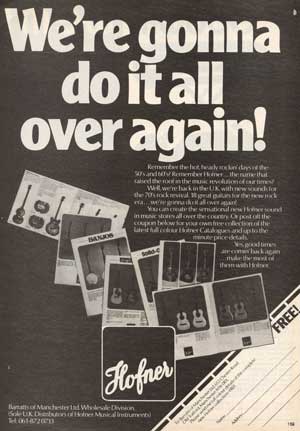
Nowadays, the
Selmer London distributed models are probably the most desirable and collectable
versions
of all the old Hӧfner guitars. That could be for two reasons, the most obvious
being that as a general statement, Ben Davies insisted that those guitars being
supplied to Selmer had more deluxe features such as mother of pearl inlays than
Hӧfner’s standard range of models. Less obvious but perhaps more pertinent is
that Ben also insisted on all guitars supplied to his company being marked using
a highly regimented serial number system, whereas up until the mid-1980’s Hӧfner
did not bother with workshop-applied serial numbers for their standard range of
guitars. (Some US, Dutch, and Swedish distributors did however make a limited
attempt at numbering guitars themselves before the mid-1980’s.)
Hӧfner could not have wished for a better distributor than
Selmer London.
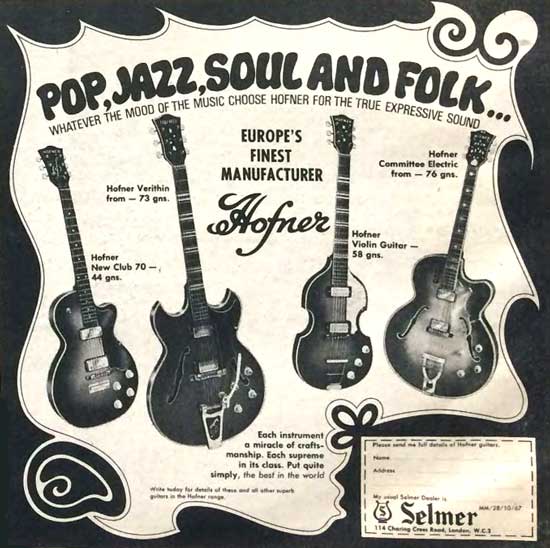
October 1967 Selmer Advertisement
__________________________________________________
All Text is Copyright
© 2022 Steve Russell. All Rights Reserved